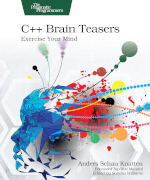You've answered 0 of 188 questions correctly. (Clear)
Question #116 Difficulty: 
According to the C++23 standard, what is the output of this program?
#include <iostream>
#include <utility>
int y(int &) { return 1; }
int y(int &&) { return 2; }
template <class T> int f(T &&x) { return y(x); }
template <class T> int g(T &&x) { return y(std::move(x)); }
template <class T> int h(T &&x) { return y(std::forward<T>(x)); }
int main() {
int i = 10;
std::cout << f(i) << f(20);
std::cout << g(i) << g(20);
std::cout << h(i) << h(20);
return 0;
}
Hint:
The T&& in the templated function doesn't necessarily result in an rvalue reference, it depends on the type that is used to instantiate the template. If instantiated with an lvalue, it collapses to an lvalue reference, if instantiated with an rvalue, it collapses to an rvalue reference.
Problems? View a hint or try another question.
I give up, show me the answer (make 3 more attempts first).
Mode : Training
You are currently in training mode, answering random questions. Why not Start a new quiz? Then you can boast about your score, and invite your friends.
Contribute
C++ Brain Teasers
Get the book, support the site!
